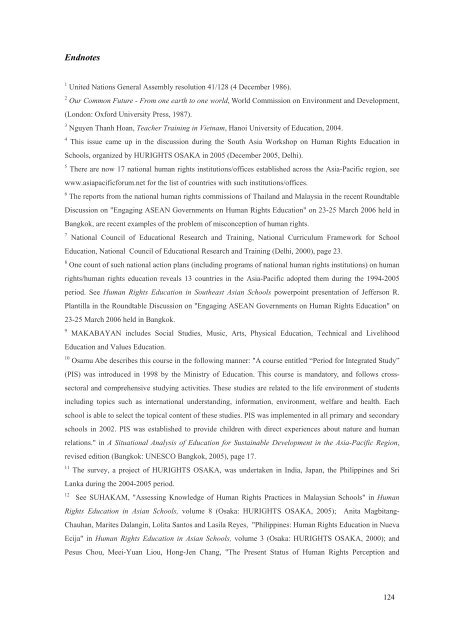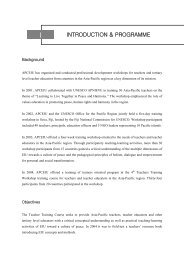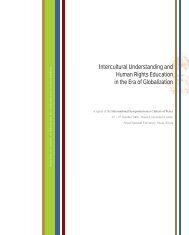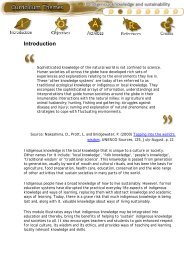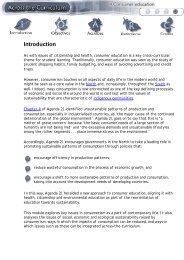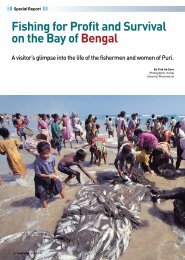REPORT OF UNESCO EXPERT MEETING ON - APCEIU
REPORT OF UNESCO EXPERT MEETING ON - APCEIU
REPORT OF UNESCO EXPERT MEETING ON - APCEIU
You also want an ePaper? Increase the reach of your titles
YUMPU automatically turns print PDFs into web optimized ePapers that Google loves.
Endnotes<br />
1 United Nations General Assembly resolution 41/128 (4 December 1986).<br />
2 Our Common Future - From one earth to one world, World Commission on Environment and Development,<br />
(London: Oxford University Press, 1987).<br />
3 Nguyen Thanh Hoan, Teacher Training in Vietnam, Hanoi University of Education, 2004.<br />
4 This issue came up in the discussion during the South Asia Workshop on Human Rights Education in<br />
Schools, organized by HURIGHTS OSAKA in 2005 (December 2005, Delhi).<br />
5 There are now 17 national human rights institutions/offices established across the Asia-Pacific region, see<br />
www.asiapacificforum.net for the list of countries with such institutions/offices.<br />
6 The reports from the national human rights commissions of Thailand and Malaysia in the recent Roundtable<br />
Discussion on "Engaging ASEAN Governments on Human Rights Education" on 23-25 March 2006 held in<br />
Bangkok, are recent examples of the problem of misconception of human rights.<br />
7 National Council of Educational Research and Training, National Curriculum Framework for School<br />
Education, National Council of Educational Research and Training (Delhi, 2000), page 23.<br />
8 One count of such national action plans (including programs of national human rights institutions) on human<br />
rights/human rights education reveals 13 countries in the Asia-Pacific adopted them during the 1994-2005<br />
period. See Human Rights Education in Southeast Asian Schools powerpoint presentation of Jefferson R.<br />
Plantilla in the Roundtable Discussion on "Engaging ASEAN Governments on Human Rights Education" on<br />
23-25 March 2006 held in Bangkok.<br />
9 MAKABAYAN includes Social Studies, Music, Arts, Physical Education, Technical and Livelihood<br />
Education and Values Education.<br />
10 Osamu Abe describes this course in the following manner: "A course entitled “Period for Integrated Study”<br />
(PIS) was introduced in 1998 by the Ministry of Education. This course is mandatory, and follows crosssectoral<br />
and comprehensive studying activities. These studies are related to the life environment of students<br />
including topics such as international understanding, information, environment, welfare and health. Each<br />
school is able to select the topical content of these studies. PIS was implemented in all primary and secondary<br />
schools in 2002. PIS was established to provide children with direct experiences about nature and human<br />
relations." in A Situational Analysis of Education for Sustainable Development in the Asia-Pacific Region,<br />
revised edition (Bangkok: <strong>UNESCO</strong> Bangkok, 2005), page 17.<br />
11 The survey, a project of HURIGHTS OSAKA, was undertaken in India, Japan, the Philippines and Sri<br />
Lanka during the 2004-2005 period.<br />
12<br />
See SUHAKAM, "Assessing Knowledge of Human Rights Practices in Malaysian Schools" in Human<br />
Rights Education in Asian Schools, volume 8 (Osaka: HURIGHTS OSAKA, 2005); Anita Magbitang-<br />
Chauhan, Marites Dalangin, Lolita Santos and Lasila Reyes, "Philippines: Human Rights Education in Nueva<br />
Ecija" in Human Rights Education in Asian Schools, volume 3 (Osaka: HURIGHTS OSAKA, 2000); and<br />
Pesus Chou, Meei-Yuan Liou, Hong-Jen Chang, "The Present Status of Human Rights Perception and<br />
124


